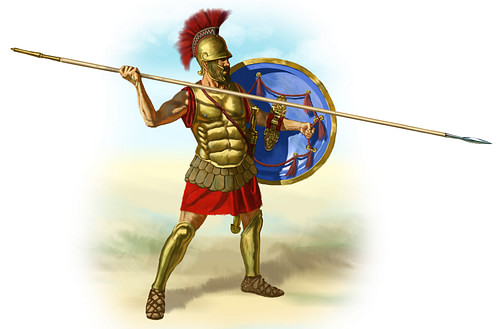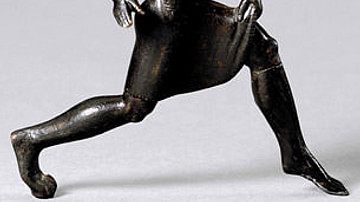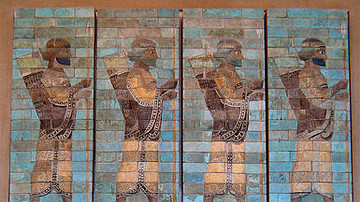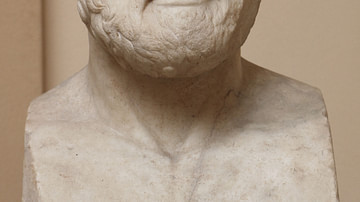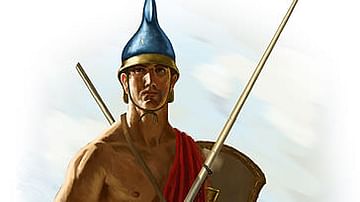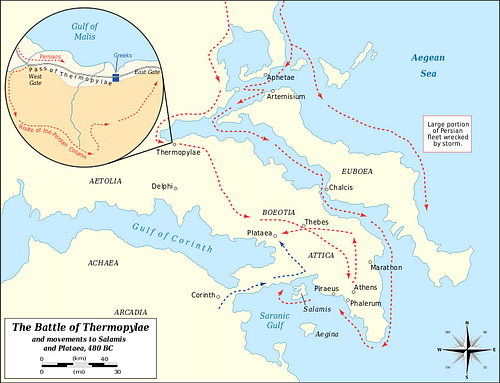
Thermopylae is a mountain pass near the sea in northern Greece which was the site of several battles in antiquity, the most famous being that between Persians and Greeks in August 480 BCE. Despite being greatly inferior in numbers, the Greeks held the narrow pass for three days with Spartan king Leonidas fighting a last-ditch defence with a small force of Spartans and other Greek hoplites. Ultimately the Persians took control of the pass, but the heroic defeat of Leonidas would assume legendary proportions for later generations of Greeks, and within a year the Persian invasion would be repulsed at the battles of Salamis and Plataea.
Context: The Persian Wars
By the first years of the 5th century BCE, the Persian Achaemenid Empire, under the rule of Darius I (r. 522-486 BCE), was already expanding into mainland Europe and had subjugated Thrace and Macedonia. Next in King Darius' sights were Athens and the rest of Greece. Just why Greece was coveted by Persia is unclear. Wealth and resources seem an unlikely motive; other more plausible suggestions include the need to increase the prestige of the king at home or to quell once and for all a collection of potentially troublesome rebel states on the western border of the empire.
Whatever the exact motives, in 491 BCE Darius sent envoys to call for the Greeks' submission to Persian rule. The Greeks sent a no-nonsense reply by executing the envoys, and Athens and Sparta promised to form an alliance for the defence of Greece. Darius' response to this diplomatic outrage was to launch a naval force of 600 ships and 25,000 men to attack the Cyclades and Euboea, leaving the Persians just one step away from the rest of Greece. In 490 BCE Greek forces led by Athens met the Persians in battle at Marathon and defeated the invaders. The battle would take on mythical status amongst the Greeks, but in reality it was merely the opening overture of a long war with several other battles making up the principal acts. Persia, with the largest empire in the world, was vastly superior in men and resources and now these would be fully utilised for a full-scale attack.
In 486 BCE, Xerxes I (r. 486-465 BCE) became king upon the death of Darius and massive preparations for invasion were made. Depots of equipment and supplies were laid, a canal dug at Chalkidike, and boat bridges built across the Hellespont to facilitate the movement of troops. Greece was about to face its greatest ever threat, and even the oracle at Delphi ominously advised the Athenians to 'fly to the world's end'.
The Pass of Thermopylae
When news of the invading force reached Greece, the initial Greek reaction was to send a force of 10,000 hoplites to hold position at the valley of Tempē near Mt. Olympos, but these withdrew when the massive size of the invading army was revealed. Then after much discussion and compromise between Greek city-states, suspicious of each others' motives, a joint army of between 6,000 and 7,000 men was sent to defend the pass at Thermopylae through which the Persians must enter mainland Greece. The Greek forces included 300 Spartans and their helots with 2,120 Arcadians, 1,000 Lokrians, 1,000 Phokians, 700 Thespians, 400 Corinthians, 400 Thebans, 200 men from Phleious, and 80 Mycenaeans.
The relatively small size of the defending force has been explained as a reluctance by some Greek city-states to commit troops so far north, and/or due to religious motives, for it was the period of the sacred games at Olympia and the most important Spartan religious festival, the Karneia, and no fighting was permitted during these events. Indeed, for this very reason, the Spartans had arrived too late at the earlier Battle of Marathon. Therefore, the Spartans, widely credited as being the best fighters in Greece and the only polis with a professional army, contributed only a small advance force of 300 hoplites (from an estimated 8,000 available) to the Greek defensive force, these few being chosen from men with male heirs.
In addition to the land forces, the Greek poleis sent a fleet of trireme warships which held position off the coast of Artemision (or Artemisium) on the northern coast of Euboea, 40 nautical miles from Thermopylae. The Greeks would amass over 300 triremes and perhaps their main purpose was to prevent the Persian fleet sailing down the inland coast of Lokris and Boeotia.
The pass of Thermopylae, located 150 km north of Athens was an excellent choice for defence with steep mountains running down into the sea leaving only a narrow marshy area along the coast. The pass had also been fortified by the local Phokians who built a defensive wall running from the so-called Middle Gate down to the sea. The wall was in a state of ruin, but the Spartans made the best repairs they could in the circumstances. It was here, then, in a 15-metre wide gap with a sheer cliff protecting their left flank and the sea on their right, that the Greeks chose to make a stand against the invading army. Having somewhere in the region of 80,000 troops at his disposal, the Persian king, who led the invasion in person, first waited four days in expectation that the Greeks would flee in panic. When the Greeks held their position, Xerxes once again sent envoys to offer the defenders a last chance to surrender without bloodshed if the Greeks would only lay down their arms. Leonidas' bullish response to Xerxes request was 'molōn labe' or 'come and get them' and so battle commenced.
Hoplites vs Archers
The two opposing armies were essentially representative of the two approaches to Classical warfare - Persian warfare favoured long-range assault using archers followed up with a cavalry charge, whilst the Greeks favoured heavily-armoured hoplites, arranged in a densely packed formation called the phalanx, with each man carrying a heavy round bronze shield and fighting at close quarters using spears and swords. The Persian infantry carried a lightweight (often crescent-shaped) wicker shield and were armed with a long dagger or battleaxe, a short spear, and composite bow. The Persian forces also included the Immortals, an elite force of 10,000 who were probably better protected with armour and armed with spears. The Persian cavalry were armed as the foot soldiers, with a bow and an additional two javelins for throwing and thrusting. Cavalry, usually operating on the flanks of the main battle, were used to mop up opposing infantry put in disarray after they had been subjected to repeated salvos from the archers. Although the Persians had enjoyed the upper hand in previous contests during the recent Ionian revolt, the terrain at Thermopylae would better suit Greek warfare.
Although the Persian tactic of rapidly firing vast numbers of arrows into the enemy must have been an awesome sight, the lightness of the arrows meant that they were largely ineffective against the bronze-armoured hoplites. Indeed, Spartan indifference is epitomised by Dieneces, who, when told that the Persian arrows would be so dense as to darken the sun, replied that in that case the Spartans would have the pleasure of fighting in the shade. At close quarters, the longer spears, heavier swords, better armour, and rigid discipline of the phalanx formation meant that the Greek hoplites would have all of the advantages, and in the narrow confines of the terrain, the Persians would struggle to make their vastly superior numbers tell.
Battle
On the first day, Xerxes sent his Median and Kissian troops, and after their failure to clear the pass, the elite Immortals entered the battle but in the brutal close-quarter fighting, the Greeks held firm. The Greek tactic of feigning a disorganised retreat and then turning on the enemy in the phalanx formation also worked well, lessening the threat from Persian arrows and perhaps the hoplites surprised the Persians with their disciplined mobility, a benefit of being a professionally trained army.
The second day followed the pattern of the first, and the Greek forces still held the pass. However, an unscrupulous traitor was about to tip the balance in favour of the invaders. Ephialtes, son of Eurydemos, a local shepherd from Trachis, seeking reward from Xerxes, informed the Persians of an alternative route —the Anopaia path— which would allow them to avoid the majority of the enemy forces and attack their southern flank. Leonidas had stationed the contingent of Phokian troops to guard this vital point but they, thinking themselves the primary target of this new development, withdrew to a higher defensive position when the Immortals attacked. This suited the Persians as they could now continue unimpeded along the mountain path and arrive behind the main Greek force. With their position now seemingly hopeless, and before their retreat was cut off completely, the bulk of the Greek forces were ordered to withdraw by Leonidas.
Last Stand
The Spartan king, on the third day of the battle, rallied his small force - the survivors from the original Spartan 300, 700 Thespians and 400 Thebans - and made a rearguard stand to defend the pass to the last man in the hope of delaying the Persians progress, in order to allow the rest of the Greek force to retreat or also possibly to await relief from a larger Greek force. Early in the morning, the hoplites once more met the enemy, but this time Xerxes could attack from both front and rear and planned to do so but, in the event, the Immortals behind the Greeks were late on arrival. Leonidas moved his troops to the widest part of the pass to utilise all of his men at once, and in the ensuing clash the Spartan king was killed. His comrades then fought fiercely to recover the body of the fallen king. Meanwhile, the Immortals now entered the fray behind the Greeks who retreated to a high mound behind the Phokian wall. Perhaps at this point the Theban contingent may have surrendered (although this is disputed amongst scholars). The remaining hoplites, now trapped and without their inspirational king, were subjected to a barrage of Persian arrows until no man was left standing. After the battle, Xerxes ordered that Leonidas' head be put on a stake and displayed at the battlefield. As Herodotus claims in his account of the battle in book VII of The Histories, the Oracle at Delphi had been proved right when she proclaimed that either Sparta or one of her kings must fall.
Meanwhile at Artemision, the Persians were battling the elements rather than the Greeks, as they lost 400 triremes in a storm off the coast of Magnesia and more in a second storm off Euboea. When the two fleets finally met, the Greeks fought late in the day and therefore limited the duration of each skirmish which diminished the numerical advantage held by the Persians. The result of the battle was, however, indecisive and on news of Leonidas' defeat, the fleet withdrew to Salamis.
The Aftermath
The battle of Thermopylae, and particularly the Spartans' role in it, soon acquired mythical status amongst the Greeks. Free men, in respect of their own laws, had sacrificed themselves in order to defend their way of life against foreign aggression. As Simonedes' epitaph at the site of the fallen stated: 'Go tell the Spartans, you who read: We took their orders and here lie dead'.
A glorious defeat maybe, but the fact remained that the way was now clear for Xerxes to push on into mainland Greece. The Greeks, though, were far from finished, and despite many states now turning over to the Persians and Athens itself being sacked, a Greek army led by Leonidas' brother Kleombrotos began to build a defensive wall near Corinth. Winter halted the land campaign, though, and at Salamis the Greek fleet manoeuvred the Persians into shallow waters and won a resounding victory. Xerxes returned home to his palace at Sousa and left the gifted general Mardonius in charge of the invasion. After a series of political negotiations it became clear that the Persians would not gain victory through diplomacy and the two armies met at Plataea in August 479 BCE. The Greeks, fielding the largest hoplite army ever seen, won the battle and finally ended Xerxes' ambitions in Greece.
As an interesting footnote: the important strategic position of Thermopylae meant that it was once more the scene of battle in 279 BCE when the Greeks faced invading Gauls, in 191 BCE when a Roman army defeated Antiochus III, and even as recent as 1941 CE when Allied New Zealand forces clashed with those of Germany.

